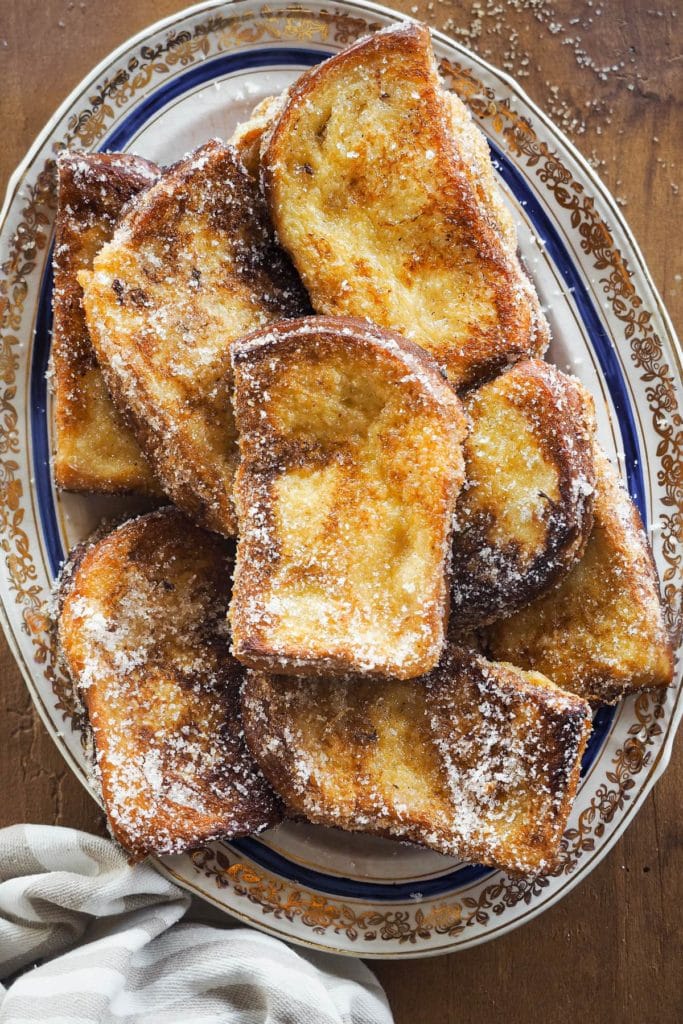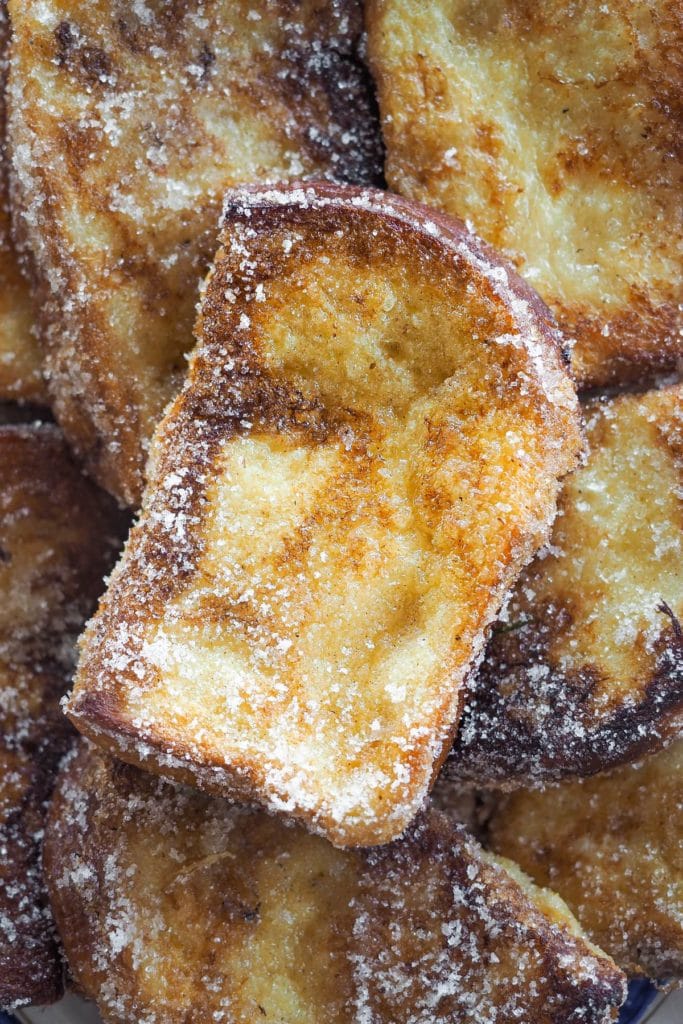If you love French toasts you’ll definitely LOVE Torrijas! They are a traditional Spanish sweet treat, which ressembles a cross between the popular French toasts and bread puddings. Imagine a creamy and moist interior with a cinnamony sugar exterior, dreamy right? They are typically eaten during Easter and especially on Good Friday, although you can find them on restaurant menus all year round nowadays. They’re really easy to make and probably you’ll see as many versions as there are Spaniards, but today I am bringing to you a traditional torrijas recipe so you can try Spanish Style French toasts next time you crave them for breakfast, brunch or dessert.

Torrijas are one of my favourite desserts (if you follow me on Instagram you will have seen that when I am eating out, if there are torrijas on the menu I always order them), but… Until a year ago I had never made them at home, can you believe it?
In Catalonia during Easter the traditional sweets are the Mona de Pascua and Buñuelos de viento (airy fritters), so Torrijas have always had a secondary role at home during this time of the year. Also, since until the pandemic I was living in the UK and over there you have the Hot Cross Buns, I wasn’t finding the moment to make them at home.
What changed last year? Well, on the one hand, we spent Easter with our family for the first time in years, and when one makes torrijas has to get ready to prepare quantity for a crowd. On the other hand, Raquel from Rapacina Repostera taught me how to make them, she’s such an incredible baker, and when it comes to traditional recipes she’s even more next level! So today’s recipe for traditional homemade torrijas is based on hers :).

Ingredients for This Traditional Torrijas Recipe
There are a thousand versions of torrijas: using plant-based milk or cream, with erythritol or honey instead of sugar, with citrus or without citrus, with chocolate… But today we’re going traditional, so this is what you’ll need:
- Bread: the base of the torrija, like in any French toast. You can use any type of bread as long as it has a dense crumb and a thin crust (don’t use ciabatta for example). Milk bread, challah, brioche or Vienna bread are fabulous for Torrijas. In the next section, we’ll go into detail about whether it’s better to use fresh or stale bread.
- Milk: to soak the bread and make it creamy. I prefer whole milk to semi or skimmed as it provides more creaminess.
- Sugar: both for soaking, so the French toast caramelizes a little when frying it, but you can omit it if you prefer, and also for coating.
- Cinnamon: a cinnamon stick to infuse the milk and ground cinnamonp for the coating.
- Egg: to coat the French toast before frying.
- Oil: sunflower oil or mild refined olive oil. We need an oil preferably with a high smoking point to be able to fry the torrijas properly without burning it. If you want to know more about this topic, in this 15-Minute Fish Nuggets recipe I went into a little more detail.

Fresh Bread or Stale Bread?
There’s is a heated debate on this topic, but I do have a preference: stale bread. The fact is that for me an indisputable quality of a good torrija is that it’s creamy in the interior and for that to happen the bread hast to soak as much milk as possible without dripping afterwards. The staler the bread is, the more liquid it can absorb and the creamier and moister the torrija will be at the end.
Furthermore, Torrijas are without a doubt our quintessential dessert to reuse stale bread and it must be for a reason :).

Alternatives for Infusing the Milk of These Spanish Style French Toasts
In this torrijas recipe I have only used cinnamon, which is how Raquel taught me, but if you don’t like it or don’t have it on hand, you can use other ingredients. A classic option is to use orange and/or lemon skin. You can also use other aromatic spices such as vanilla, cloves, star anise or cardamom.
If using a citrus skin, try to peel it without the white part, as it’s a bit bitter.

How to Store Torrijas
It’s best to eat the torrijas freshly made, since that is when mainly the exterior is at its best, with a crispy touch thanks to the sugar coating. The interior holds better for longer, but as the torrija cools it may lose creaminess, while still remaining moist – with time the crumb settles.
If you have any leftovers though, store them in an airtight container at room temperature.

Frequently Asked Questions
How do I know the oil is ready for frying?
To know if the oil has reached the right temperature without a kitchen thermometer, the trick is to throw a piece of torrija in it. If you see that the oik sizzles, it’s ready. Otherwise, wait a little longer before you start frying them. If you have a kitchen thermometer, the temperature would be 170ºC for sunflower oil and 180ºC for olive oil.
What do I do with leftover egg?
The recipe calls for 2 L-sized eggs, but after all, the exact quantity varies from egg to egg so you might end up with a little leftover. Just don’t throw it away, store it to make an omelette or scrambled eggs for dinner or breakfast, or to coat chicken breasts for example if you are making breaded chicken.
What do I do with leftover cinnamony sugar?
Again, don’t throw it away, store it in an airtight container (or glass jar) in a cupboard and use it in other sweet treats: in a cinnamon sponge cake, cinnamon rolls, cookies, to sweeten your morning porridge if you usually add a little sugar in it, whatever you want!
If you see that it has some lumps due to the oil, you can sieve the mixture first to get rid of the oily lumps (don’t press them so they pass trough the sieve, simply discard them).

More Sweet Treats Perfect for Easter
Even if these are not so traditional, they are also perfect to make during the Easter holidays:
- Strawberry Brownie Cheesecake
- Strawberry Galette with Vanilla Whipped Cream
- One Bowl Iced Lemon Ricotta Loaf Cake
If you make this Torrijas. Spanish Style French Toasts recipe, be sure to leave a comment and rate it. Hearing from you is everything! Oh, and don’t forget to tag me on Instagram, I absolutely love seeing your creations. Happy cooking!
Torrijas. Spanish Style French Toasts
Ingredients
Soaking
- 10 slices of bread - 3 cm thick (see notes)
- 600 ml milk - preferably whole
- 2 tbsp sugar
- 1 cinnamon stick
Frying
- 2 L eggs
- Oil - sunflower or mild olive oil. Enough to cover the bottom of a pan and raise 1 cm.
Coating
- 1 tsp ground cinnamon - more/less to taste
- 60 g sugar
Instructions
Soaking
- Arrange the bread in a tray, so that the slices touch each other but without overlapping. If you can’t fit them all in one tray, use an extra shallow plate. Set aside.
- Place the milk in a saucepan with the sugar and the cinnamon stick. Bring to a boil and when it starts to boil, turn off the heat, cover the saucepan and let it sit until it cools down.
- Scoop out the cinnamon from the milk and pour it over the bread. If you have the bread spread over different plates or trays, distribute the milk proportionally. Let the bread absorb the milk for a couple of minutes and flip the slices (this ensures the interior gets uniformly creamy when frying them). Allow the milk to be completely absorbed.
- Meanwhile, whisk the eggs on a plate and set aside. In another plate, mix the sugar and cinnamon for the coating and set aside.
Frying
- Heat the oil in a pan over medium heat.
- Dip the bread slices in the beaten egg on both sides.
- When the oil is ready (170ºC for sunflower oil, 180ºC for olive oil or if you don’t have a thermometer, the oil should sizzle if you throw a piece of bread in it), using a slotted spoon or fork, drain off the excess egg and fry the torrija for about 1 minute per side. They should be golden on both sides. See notes.
- Transfer the torrijas to a plate with kitchen paper.
Coating
- While the torrijas are still hot, coat them with the sugar and cinnamon mixture and enjoy them freshly made!
Notes
- Use a loaf of bread preferably with a dense crumb and stale. Types of bread that work really well: challah, Vienna bread, brioche or milk bread for example.
- Throughout the frying process, try to keep the oil clean. You can use a slotted spoon from time to time to remove the bits and pieces here and there.
Did you make this recipe?
Please let me know how it turned out for you! Leave a comment below and tag @paulasapron on Instagram and hashtag it #paulasapron.